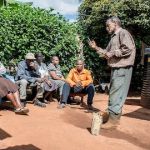Five Imperatives to Help Address the Challenges of Sustainable Rural Economic Development
In order to reduce poverty in rural areas, local sustainable economic development is essential. According to last year’s Least Developed Countries Report by the UN Conference on Trade and Development, subtitled “Transforming Rural Economies,” more than two-thirds of the populations in the least-developed countries live and work in rural areas and the proportion of people living below the poverty line in rural areas is generally double that of urban areas.
We believe there are five key imperatives to optimise rural economic development in a sustainable manner.
1. Access to credit and financial services
Provision of credit in remote areas enables people to access funds to grow or start businesses, improve their farming methods and increase productivity. It is often difficult and expensive to provide because of the distances, lack of population density, poor transport and power infrastructure. While developments in mobile technology are helping to lessen the cost burden, meaningful-sized loans for building livelihoods require direct interaction and support, often as part of a group.
Another big challenge for sustainable credit can be the well-meaning introduction of interest rate caps, which can have a disproportionate impact in rural areas where costs of delivery are higher. As a result, fewer providers have entered the market. In Mali, for example, the VisionFund Microfinance Institution (MFI) is the only financial service provider of any kind in poor rural areas and that is only because of funding from donors. No rational for-profit organisation would operate there unless it was subsidised. Interest caps are one of the biggest threats to rural financial inclusion.
2. Coming together into more powerful ‘producer’ groups
We make credit available to individuals who come together to form a group. The group then offers a form of mutual support for its members. There is even greater value for the farmers, where those growing the same crops come together in organised groups to receive joint training, buy inputs in bulk and start to sell as a single body. With the proper training in agriculture and business provided by VisionFund, World Vision and our partners, such groups become self-governing and ease their reliance on aid, NGOs or governments. This also enables a greater scale of transformation in terms of individuals and communities.
Smallholder farmer producer groups are a key component of creating true scale because of the confidence, support and buyer/seller power they provide. We have seen the practical results of this in our recent work with World Vision which we are now rolling out across five African countries. The initiatives include group formation, technical training, loans for crop inputs and access to new markets. Since piloting this work three years ago in Tanzania, the project has reached over 9,000 direct and 20,772 indirect beneficiaries as of the second quarter of fiscal year 2016, and we have observed farmers’ income increases per family of 200-plus percent. While the project is ongoing, the results obtained so far have rippled, changing communities with many new houses in brick with tin roofing and children very obviously better off and in school.
3. Accessing new/better markets and prices
Increasing agricultural productivity is not enough. Teaching and enabling farmers to access bigger markets regionally, nationally or internationally so that they can sell their produce for an equal or better price, is what will make a difference in farmers’ lives.
Tactically, this can take many forms, such as helping farmers access geographically better and varied markets in terms of product value and demand. It might be facilitating bulk sales to a regional national market rather than by the side of the road locally, switching to a higher value crop, or finding different ways to access the market such as canning or sun-drying vegetables.
World Vision has for the past few years been testing different approaches in Tanzania, starting with building community producer groups and then introducing those groups to larger buyers. Whilst transformation occurred, the scale of change was limited by the poor value chain infrastructure. The next phase was to set up a company to focus on filling that infrastructure void and join smallholder farmers to export markets for higher-value crops. In 2016, this moved to a more advanced level by partnering with an existing cereal exporting company in Tanzania to focus on exporting selected cereal and vegetable products at sustainable prices to European buyers. More on these efforts can be found in the video below.
4. Women’s participation in the local rural economy
About 70 percent of VisionFund’s clients are women, and with appropriate initial financial training, our experience is that women grow some of the most successful microenterprises.
Other research points toward greater impact on children, both short-term and generational, and of women accessing credit services to start and grow small businesses:
- A study of 819 households in areas of Ethiopia afflicted by drought and food insecurity found that children in households with female microcredit clients had significantly better nutritional status than control populations or children in households with male clients (Doocy et al., 2005).
- A study in Tamil Nadu in Sri Lanka from 1998 found that girls living in households where credit was sourced through women’s groups remained on average about one to one-and a-half years longer in school, were 3.2 to 3.9 times more likely to be enrolled in private rather than in public schools, and were 2.7 to 3.5 times more likely to be literate (Holvoet, 2004).
5. Partnerships
A variety of partnership types are required for sustainable changes to take place in rural communities. These include government, private sector companies, NGOs, multilateral government organisations, farmer organisations and local community groupings.
Ultimately it is about coming together with local people to help them create or influence the right set of circumstances as described above. New partners and players are becoming relevant to this, such as mobile phone companies and money transmission organisations.
The private sector will be critical if we are going to see transformation in future years. In the past few years, the motivation driving such private-sector partnerships has demonstrably changed. They are now increasingly larger scale sustainable partnerships because they are seeking out true joint commercial benefit, rather than being CSR PR exercises.
The development of rural economies is critical for poor countries to meet their sustainable development goals. Bringing these different elements outlined above together helps to hand the power back to the communities, to ease the reliance on aid and enable self-determination. As NGOs, we all need to think about how we can help communities to maximise opportunities and support them to create secure and sustainable livelihoods.
Peter Harlock is global strategy director for VisionFund International, the microfinance arm of World Vision, a global humanitarian agency.
Photo above: A Tanzanian farmer – and VisionFund client – harvests his crop. Photo courtesy of VisionFund
Photo on the homepage: A woman displays her hand-crafted jewelry funded in part with a loan from VisionFund Tanzania. Photo courtesy of VisionFund
- Categories
- Uncategorized



